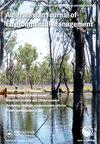建立一个有效的指标来衡量东部卷尾鱼在潮间带觅食区的栖息地质量
IF 1.5
4区 社会学
Q4 ENVIRONMENTAL STUDIES
Australasian Journal of Environmental Management
Pub Date : 2022-07-12
DOI:10.1080/14486563.2022.2084166
引用次数: 0
摘要
摘要候鸟在冬季非繁殖季节在潮间带湿地觅食,以满足它们的日常需求,并为飞往繁殖地积累储备。然而,这些栖息地可能会受到发展的影响。澳大利亚东部杓鹬(Numenius madagascarensis)的种群数量正在下降,我们在澳大利亚昆士兰州东南部莫尔顿湾的11个滩涂上评估了杓鹬的觅食行为、猎物类型、广泛基质类型、觅食微栖息地偏好和种群密度之间的关系。大多数猎物是大小不等的甲壳类动物。在平地内,喂养行为的类型和比率以及喂养成功率因性别、微生境和潮汐阶段而异。在不同的平地中,估计的猎物生物量摄入率与杓鹬密度密切相关,解释了其57%的变化(2-77只/100只) ha);而每单位时间的进食尝试和成功的进食行为都不是良好的密度预测因子。基质抗性与生物量摄入和杓鹬密度呈负相关,因为杓鹬能够利用它们的长喙从更具穿透性的平地中的深洞穴中提取更大的猎物。因此,杓鹬直接根据食物供应选择觅食区域,但基质渗透性为栖息地质量的区域尺度变化提供了一个很有前途的快速指标。本文章由计算机程序翻译,如有差异,请以英文原文为准。
Towards an efficient indicator of habitat quality for Eastern Curlews on their intertidal feeding areas
ABSTRACT Migratory shorebirds feed in intertidal wetlands during the winter non-breeding season, to meet their daily needs and accumulate reserves for the flight to their breeding grounds. However, these habitats may be impacted by development. Eastern Curlew (Numenius madagascariensis) populations are declining in Australia, where we assessed relationships among the curlews’ feeding behaviours, prey types, broad substrate types, feeding microhabitat preferences, and population density, across 11 tidal flats in Moreton Bay, South East Queensland, Australia. Most prey were crustaceans, of varied size. Within flats, the types and rates of feeding actions, and feeding success, varied with sex, microhabitat and tidal stage. Among different flats, the estimated rate of prey biomass intake was strongly correlated with curlew density, explaining 57 per cent of its variation (2–77 birds/100 ha); whereas neither feeding attempts nor successful feeding acts per unit time were good density predictors. Substrate resistance was negatively correlated with both biomass intake and curlew density, because curlews were able to use their long bills to extract larger prey from deep burrows in more penetrable flats. The curlews, therefore, chose feeding areas directly according to food supply, but the substrate penetrability provides a promising rapid indicator of regional-scale variation in habitat quality.
求助全文
通过发布文献求助,成功后即可免费获取论文全文。
去求助
来源期刊

Australasian Journal of Environmental Management
ENVIRONMENTAL STUDIES-
CiteScore
2.60
自引率
0.00%
发文量
16
 求助内容:
求助内容: 应助结果提醒方式:
应助结果提醒方式:


